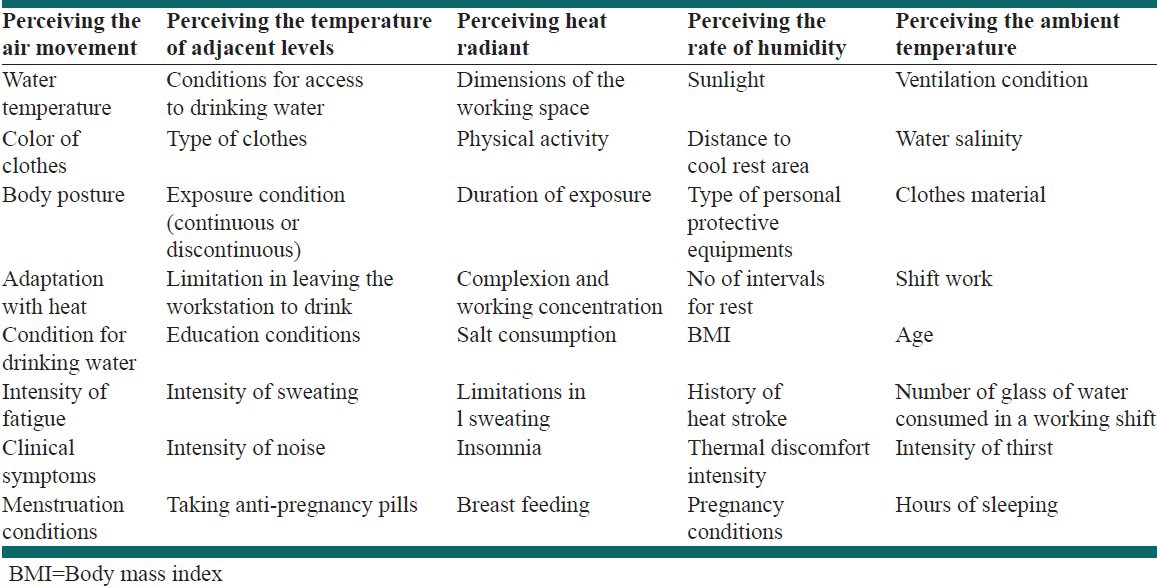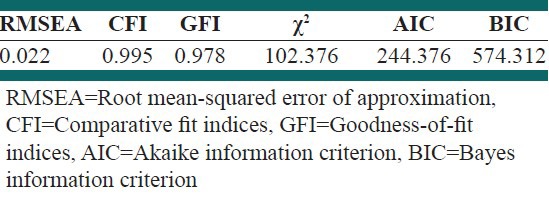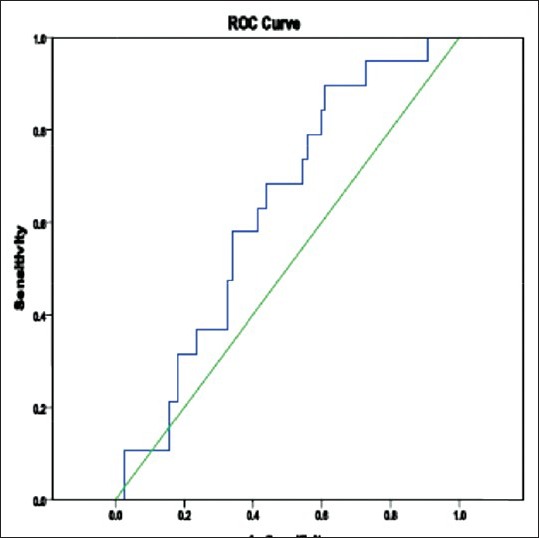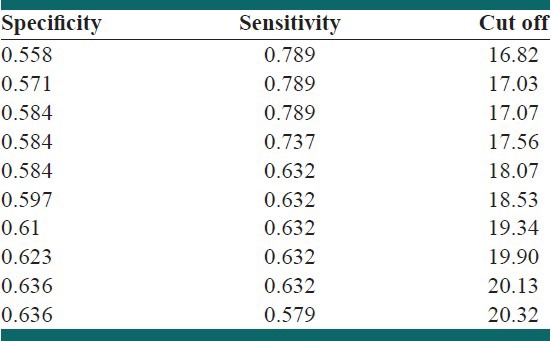Abstract
Introduction:
Physiological, anthropometrical and thermal perceptual are the most important factors affecting thermoregulation of men and women in workplaces. The purpose of this study was determining the validity of a questionnaire method for assessing women's heat strain in workplaces.
Methods:
This cross-sectional study was carried out on 96 healthy women. Data were continuously collected over a period of 3 months (July-September) in 2012. Mean ± (SD) of age was found to be 31.5 ± 7.48 years, of height 1.61 ± 0.05 m, of weight 61.55 ± 10.35 kg, and of body mass index 23.52 ± 3.75 kg/m2 in different workplaces. Heart rate and oral temperature were measured by heart rate monitoring and a medical digital thermometer, respectively. Subjects completed a draft questionnaire about the effective factors in the onset of heat strain. After collecting the questionnaires, the data were analyzed by applying Cronbach’sa calculation, factor analysis method, Pearson correlation and receiver operator characteristic curves using the SPSS 18 software.
Results:
The value for Cronbach's α was found to be 0.68. The factor analysis method on items of draft questionnaire extracted three subscale (16 variables) which they explained 63.6% of the variance. According to the results of receiver operator characteristic curve analysis, the cut-off questionnaire score for separating people with heat strain from people with no heat strain was obtained to be 17.
Conclusions:
The results of this research indicated that this quantitative questionnaire has an acceptable reliability and validity, and a cut-off point. Therefore it could be used in the preliminary screening of heat strain in women in warm workplaces, when other heat stress evaluation methods are not available.
Keywords: Heat strain, questionnaire, women
INTRODUCTION
Heat is a physical hazard that could create problems almost in all working environments, especially during the warm months.[1] Heat stress has a significant relationship with reduced performance.[2,3,4] Hence, in recent decades the effects of environmental factors and an individual's factors on physiologic strains due to heat (heart rate, body core temperature and the sweat rate) have been attempted to be evaluated, and an index or criterion has been tried to be presented in a numerical frame known as as heat stress index.[5] Among the empirical indices, the wet bulb globe temperature index is used as the evaluating index for heat stress caused by environment factors. To calculate wet bulb globe temperature index, it is necessary to use wet bulb temperature (TW), black globe temperature (Tg) and dry bulb temperature (Ta) (for outdoor).[6] The physiological strain index was established and evaluated by Moran, which is an evaluating index for physiological strains, considering the input load to the cardiovascular system and body thermoregulation.[7] Sometimes, the measuring process intervenes with workplace activities by some indices and its application is practically difficult in working fields. Sometimes the measuring process requires rather long time (wet bulb globe temperature index).[7,8] Although direct indices are more applicable as compared with other indices, they only involve the environmental variables such as wet bulb, dry bulb and black globe temperatures. In this regard, Cheung suggested that not only should physiologic responses be used in occupational confrontation standards, but the thermal perceptions that are perceptual responses to heat stress should also be considered.[9]
In a study performed by Dehghan et al.,[10] for content reliability and validation of the structure of the heat stress score index in the climatic conditions of Iran for the male population, results showed that the heat stress score index scale is a reliable and suitable method for screening heat stress in Iran. But regarding the anatomic, physiologic and emotional differences between men and women, the results could not be generalized and considered for women, since gender could also affect the rate of heart stress that a person could tolerate.[11] The results showed that although the density of activated sweat glands is greater in women, the sweat rate in young women and also old women is less than that in men. Therefore, sweat production by the glands is considerably low in women.[12] There are different important thermoregulatory factors both in men and women, including specific physiologic factors in women (sex hormones, body water regulation, exercise capacity, anthropometric specifications (weight and body size), body structure (muscles and body fat content) and social behavioral specification (daily physical activity).[13]
The results obtained at the end of three activities in a study by Gagnon et al., showed that the body core temperature in women is 38.12 ± 0.18°C as compared with 37.52 ± 0.37°C in men and the esophagus temperature in women is 38.14 ± 0.20°C as compared with 37.41 ± 0.33°C in men. Thus women get tired sooner than men when performing activities and hence production rate decreases, and they need more time to rest while performing similar working activities.[14]
In a study by Yokota et al., of women soldiers, five main factors of physical structure specification (tall–fat, tall–thin, average, short–thin, short, obese) were analyzed by anthropometric multiple considerations. Results under similar heat stress showed different tolerance levels, and that body core temperature (Tc) in these women was less than that in obese–short or fat–tall women.[15]
Due to a lot of differences between men and women regarding heat exposure and also due to differences in perceptions between men and women with regard to ambient temperature, it is necessary to evaluate the effect of heat stress in employed women. The difference in regulating temperature is usually evidenced by the greater body temperature that is quite harmful for women in very hot environments. Compared with men, women require (a) a considerable amount of fat that acts as an insulator and increases heat or thermal storage; (b) a thermoregulation system for high temperatures; and (c) less aerobic capacity, which increases the relative working load of an activity.[16] Researchers have found that men have less heart rate than women for a given level of heat stress.[17] Also the area of body covered is greater in women than men in Islamic communities, which probably affects the heat transfer between the body and the environment. Therefore, the purpose of this study was to validate a questionnaire for heat strain evaluation in women.
METHODS
Subjects
This cross-sectional research was performed on 96 healthy employed women, during summer in 2012. Mean ± (SD) of age was found to be 31.5 ± 7.48 years, of height 1.61 ± 0.05 m, of weight 61.55 ± 10.35 kg, and of body mass index 23.52 ± 3.75 kg/m2 in different workplaces. They worked in different warm workplaces, including greenhouse settings, hospital laundry, and confectionary factories. Subjects were selected by systematic random sampling. The inclusion criteria were non-cold disease during the past week, diabetes, epilepsy, convulsion, hyperthyroidism, respiratory diseases, cardiovascular diseases, and not consuming medicines. The exclusion criteria were non-participation and non-cooperation in measuring heart rate and oral temperature. This study was performed after getting permission from the Ethic Committee in Medicine.
Measurements
After selecting a subject, her height and weight were measured (weight by a digital scale with 0.1-kg accuracy). The belt-like sensor of the heart-rate monitoring device (Polar Electro RS100, Finland) was fastened to the chest and the monitor was fastened to the participant's wrists.[18] Also, oral temperature was measured by a medical digital thermometer (Digital Thermometer; Omron). Oral temperature was measured for 5 min with a closed mouth and in conditions where environment temperature (ambient temperature) was over 18°C, prohibited from eating, drinking, and smoking for at least 15 min before the measurement, to reduce the effect of environmental conditions.[19] Heart rate and oral temperature were measured in the resting and working states. After 15 min of rest out of the warm workstation (cool place), heart rate and oral temperature were measured as baseline. Then the subject started to work, and heart rate and oral temperature were measured every 5 min for 120 min. For simultaneous measurement of physiological parameters, a questionnaire, including 45 items, was asked to be filled out in the resting and working states every 30 min for 120 min (four times). This questionnaire included the most important probable factors in onset of heat [Table 1].[20,21,22,23,24]
Table 1.
Probable effective factors onset heat strain

The value of Cronbach's α was calculated for reliability of the questionnaire. For validity of the questionnaire's structure, calculations regarding the correlation coefficient of the questionnaire's questions, exploratory factor analysis and confirmatory factor analysis were used. The maximum likelihood method was applied for estimating the model, and to consider the fitness of the model, χ2 indices, (goodness-of-fit indices (GFI)), comparative fit indices (CFI), root mean-squared error of approximation (RMSEA), and root mean-squared residual (RMR) were used. If GFI and CFI were greater than 90%, it would indicate very appropriate fitness and if the indices were greater than 80%, it would indicate appropriate fitness. If RMR and RMSEA were less than 0.05, it indicated very suitable fitness and if they were less than 0.08, it showed acceptable fitness.[25] Finally, after calculating regression weight, which was obtained in the three-factor model, it was multiplied by the score on each of the questions selected by individuals and the total showed the total score on the questionnaire.
RESULTS
In this study the total number of participants was 142 and the mean ± SD of age was 31.5. ±7.48 years, of height 1.61 ± 0.05 m, of weight of 61.55 ± 10.35 kg, of working history 2.55 ± 0.62 years, and of body mass index of 23.52 ± 3.78 kg/m2. In this study, internal stability of the questions was estimated by using a Cronbach's α value of 0.68, on 45 questions. The variable intensity of thermal discomfort had the highest correlation (0.71) and the variable shift work had the lowest correlation as compared with the total correlation. Kaiser Meyer Olkin (KMO) test was used to analyze the adequacy (sufficiency) of the sample volume. The value of KMO for the present research was 0.89, which indicates suitability of the number of samples for performing the factor analysis.
For validity and significance of the model, analyses with one, five, four, and confirmatory factor analysis with two and three factors, were used. Variables that had item–total correlation less than 0.24 were eliminated from the study. Finally, the structure was accepted according to filling the indices of a three-factor model with 16 variables. Eleven variables in the first factor (perceptual), three variables in the second factor (environmental), and three variables in the third factor (individual or personal) were considered [Table 2]. Entered variables in the perceptual factor with a factor loading of 0.20-1.36 were determined. Entered variables in the environmental factor with a loading of 0.35-1.09 were considered and entered variables in the personal factor with a factor loading of 0.30-0.53 were determined. The first factor of 42.4, second factor of 12.9, and third factor of 8.3 were taken from the variance and the total of three factors, with a variance 63.6 being determined.
Table 2.
Regression weight of the entered variables in the three-factor questionnaire

As shown in Table 3, the RMSEA, GFI and CFI indices indicate suitable fit and confirm the estimated model.
Table 3.
Fitness indices in the three-factor questionnaire

Pearson correlation test showed that there was a significant correlation between the questionnaire scores and oral temperature (r = 0.414, P < 0.001) and heart rate (r = 0.247, P = 0.015).
Oral temperature was selected as the decision criterion for determining the cut-off point, so that we considered an oral temperature of less than 37.5°C as no or low heat strain and more than 37.5°C as heat strain. Receiver operator characteristic analysis was used to calculate sensitivity, specificity, and cut-off point Area under the receiver operator characteristic curve [Figure 1], which is a global summary statistic of diagnostic accuracy, was 0.659 (P < 0.033). The appropriate cut-off point of the questionnaire was obtained to be 17, which will indicate the existence of heat strain in a person [Table 4]. Sensitivity and specificity were obtained to be 0.789 and 0.584, respectively, using this cut-off point.
Figure 1.

Area under the curve for determination of sensitivity and specificity
Table 4.
Values of sensitivity and specificity of the questionnaire in the cut-off point domain

DISCUSSION
Gender is one of the effective factors in heat exchange between the human body and the environment Hence evaluation and assessment of heat stress under different climatic conditions is essential among the male and female populations. Since men and women under heat exposure, in different studies, did not show similar results regarding heart rate and rectal temperature, under various climatic conditions and similar workplace activities,[12,13,14,17] therefore, the present study was performed with the aim of determining the validity of a questionnaire method to evaluate heat strain in women, in their workplaces.
In an perceptual–observational checklist, Bethea and Parsons[26] selected seven determining parameters for heat stress risk, of which five parameters, ambient temperature, humidity, radiant temperature average, air movement and rate of physical activity, had been entered into our questionnaire. Two variables type and material of the clothes had been eliminated from the questionnaire due to low item–total correlation.
The feeling of heat in human beings depends on their heat balance. Heat balance is in turn affected by physical activities, clothes, and climatic parameters such as ambient temperature, radiant temperature average, air velocity, and humidity.[27] All parameters apart from the variable clothes were accepted in our questionnaire with high factor loading. In a study performed by Maeen Zakaria, the most important parameters introduced in emergence of heat stress were physical activity, clothes, and climatic conditions, and the most important physiology responses to heat stress were heart rate, rectal temperature, and intensity of perspiration,[28] and all these parameters were considered in this investigation.
In a research done by Rodriguez[29] on the cooling responses to the heat stress, sweat rate was expressed as one of the most important mechanisms in cooling the body via skin. Also parameters ambient temperature, air velocity, and humidity were considered as the determining factors in sweat rate;[29] all the above parameters were accepted as being significant. Binkley et al.,[30] have recommended the use of the parameters consuming liquids and intensity of thirst during physical activities under warm climatic conditions. Mueller and Diehl[31] have stated the highest rate of heart stroke and mortality to be among athletes and people performing heavy physical activities.[31] Gaffin et al., recognized sunlight intensity as the greatest source of receiving heat under warm climatic conditions and introduced direct exposure to heat sources and radiation temperature as the next factors for receiving heat, emergence of diseases, and heat exhaustion,[32] and the above items were entered into our questionnaire.
Chengalur et al.,[33] recognized ways of controlling heat stress in workplaces, including reducing air temperature, reducing humidity, increasing air velocity, reducing physical activity intensity, wearing suitable clothes, using a heat shield, work–rest programs, replacing fluids and electrolytes, heat adaptation, and instructing workers. All the parameters were considered in our questionnaire.
In a similar study that was performed on the male population, the variables type of clothing, color of clothing, material of clothes, type of personal protective equipments, and clinical symptoms had significant factor loading in a structured questionnaire,[10] whereas these variables had no significant factor loading in our questionnaire, therefore they were eliminated. Instead, the variables solar radiation, working dimensions, duration of heat exposure, and history of heat stroke replaced them.
The present study, which was performed among the population of women in rather warm areas, showed that the rate of heat stress was not so high in this population, the reasons for which may be: (1) due to sensitivity of women to high temperatures, most of the women were doing their heavy load work during the colder times of the day; (2) providing a cold resting area was provided at a distance near workstations; (3) had a rest time for eliminating tiredness and reducing heat stress; (4) existence of cool water sources near the workstations and in short distances, which compensation for body dehydration in the individuals; and (5) evidence show that aware workers who had been encouraged to self-pacing adjusted their work under heat stress conditions to prevent the physiological pressures imposed on them.
CONCLUSIONS
The results of this research indicated that the 16 variables in our questionnaire [Appendix 1], effective in onset of heat strain, could be measured by questions and observation including key factors in the domain of heat stress. This quantitative questionnaire also has an acceptable reliability and validity, and a cut-off point, and therefore it could be used in the preliminary screening of heat strain in women in warm workplaces, when other heat stress evaluation methods are not available The results of this study have not been under any other climate conditions, hence it is recommended that the prototype should be investigated in other climate conditions.
ACKNOWLEDGMENT
This study was the result of an MSc dissertation approved by the Vice President for research of Isfahan University of Medical Sciences under project number 391056. The authors highly appreciate the women workers who participated in the study.
APPENDIX 1

Footnotes
Source of Support: Nil
Conflict of Interest: None declared
REFERENCES
- 1.Inaba R, Mirbod SM. Comparison of subjective symptoms and hot prevention measures in summer between traffic control workers and construction workers in Japan. Ind Health. 2007;45:91–9. doi: 10.2486/indhealth.45.91. [DOI] [PubMed] [Google Scholar]
- 2.Drust B, Rasmussen P, Mohr M, Nielsen B, Nybo L. Elevations in core and muscle temperature impairs repeated sprint performance. Acta Physiol Scand. 2005;183:181–90. doi: 10.1111/j.1365-201X.2004.01390.x. [DOI] [PubMed] [Google Scholar]
- 3.Thomas MM, Cheung SS, Elder GC, Sleivert GG. Voluntary muscle activation is impaired by core temperature rather than local muscle temperature. J Appl Physiol. 2006;100:1361–9. doi: 10.1152/japplphysiol.00945.2005. [DOI] [PubMed] [Google Scholar]
- 4.Ely MR, Cheuvront SN, Roberts WO, Montain SJ. Impact of weather on marathon-running performance. Med Sci Sports Exerc. 2007;39:487. doi: 10.1249/mss.0b013e31802d3aba. [DOI] [PubMed] [Google Scholar]
- 5.Malchaire J, Gebhardt H, Piette A. Strategy for evaluation and prevention of risk due to work in thermal environments. Ann Occup Hyg. 1999;43:367–76. doi: 10.1093/annhyg/43.5.367. [DOI] [PubMed] [Google Scholar]
- 6.Moran D, Pandolf K, Shapiro Y, Laor A, Heled Y, Gonzalez R. Evaluation of the environmental stress index for physiological variables. J Therm Biol. 2003;28:43–9. [Google Scholar]
- 7.Budd GM. Wet-bulb globe temperature (WBGT): Its history and its limitations. J Sci Med Sport. 2008;11:20–32. doi: 10.1016/j.jsams.2007.07.003. [DOI] [PubMed] [Google Scholar]
- 8.Claassen N, Kok R. The accuracy of the WBGT heat stress index at low and high humidity levels. 2007 [Google Scholar]
- 9.Cheung SS. Neuropsychological determinants of exercise tolerance in the heat. Prog Brain Res. 2007;162:45–60. doi: 10.1016/S0079-6123(06)62004-9. [DOI] [PubMed] [Google Scholar]
- 10.Dehghan H, Meraci MJ, Havanin AR, Jahangiri M. Construct validation of a heat strain score index with structural equation modeling. Health Syst Res. 2011;6:601–12. [Google Scholar]
- 11.Ashley CD, Luecke CL, Schwartz SS, Islam MZ, Bernard TE. Heat strain at the critical WBGT and the effects of gender, clothing and metabolic rate. Int J Ind Ergon. 2008;38:640–4. [Google Scholar]
- 12.Bar-Or O. Effect of age and gender on sweating pattern during exercise. Int J Sports Med. 1998;19(Suppl 2):S106–7. doi: 10.1055/s-2007-971970. [DOI] [PubMed] [Google Scholar]
- 13.Kaciuba-Uscilko H, Grucza R. Gender differences in thermoregulation. Curr Opin Clin Nutr Metab Care. 2001;4:533–6. doi: 10.1097/00075197-200111000-00012. [DOI] [PubMed] [Google Scholar]
- 14.Gagnon D, Dorman LE, Jay O, Hardcastle S, Kenny GP. Core temperature differences between males and females during intermittent exercise: Physical considerations. Eur J Appl Physiol. 2009;105:453–61. doi: 10.1007/s00421-008-0923-3. [DOI] [PubMed] [Google Scholar]
- 15.Yokota M, Berglund LG, Bathalon GP. Female anthropometric variability and their effects on predicted thermoregulatory responses to work in the heat. Int J Biometeorol. 2012;56:379–85. doi: 10.1007/s00484-011-0441-6. [DOI] [PubMed] [Google Scholar]
- 16.Reneau PD, Bishop PA, Ashley CD. AIHA J. Vol. 60. Fairfax, VA: 1999. A comparison of physiological responses to two types of particle barrier, vapor permeable clothing ensembles; pp. 495–501. [DOI] [PubMed] [Google Scholar]
- 17.McLellan TM. Sex-related differences in thermoregulatory responses while wearing protective clothing. Eur J Appl Physiol Occup Physiol. 1998;78:28–37. doi: 10.1007/s004210050383. [DOI] [PubMed] [Google Scholar]
- 18.Lumingu HM, Dessureault P. Physiological responses to heat strain: A study on personal monitoring for young workers. J Therm Biol. 2009;34:299–305. [Google Scholar]
- 19.Parsons K. Heat stress standard ISO 7243 and its global application. Ind Health. 2006;44:368–79. doi: 10.2486/indhealth.44.368. [DOI] [PubMed] [Google Scholar]
- 20.Dehghan SH, Mortazavi SB, Jafari MJ, Khavanin A. Structural equation modeling application to determine validity of the structure of a thermal strain screening method. Health Syst Res. 2011;6:601–612. [Google Scholar]
- 21.Shechter A, Boudreau P, Varin F, Boivin DB. Predominance of distal skin temperature changes at sleep onset across menstrual and circadian phases. J Biol Rhythms. 2011;26:260–70. doi: 10.1177/0748730411404677. [DOI] [PubMed] [Google Scholar]
- 22.Vähä-Eskeli KK, Erkkola RU, Seppänen A, Poranen AK, Säteri U. Haemodynamic response to moderate thermal stress in pregnancy. Ann Med. 1991;23:121–6. doi: 10.3109/07853899109148035. [DOI] [PubMed] [Google Scholar]
- 23.Grucza R, Pekkarinen H, Titov EK, Kononoff A, Hänninen O. Influence of the menstrual cycle and oral contraceptives on thermoregulatory responses to exercise in young women. Eur J Appl Physiol. 1993;67:279–85. doi: 10.1007/BF00864229. [DOI] [PubMed] [Google Scholar]
- 24.Inoue Y, Tanaka Y, Omori K, Kuwahara T, Ogura Y, Ueda H. Sex- and menstrual cycle-related differences in sweating and cutaneous blood flow in response to passive heat exposure. Eur J Appl Physiol. 2005;94:323–32. doi: 10.1007/s00421-004-1303-2. [DOI] [PubMed] [Google Scholar]
- 25.Alexopoulos D, Kalaitzidis I. Psychometric properties of eysenck personality questionnaire-revised (EPQ-R) short scale in greece. Pers Individ Dif. 2004;37:1205–20. [Google Scholar]
- 26.Bethea D, Parsons K. England: Loughborough University; 2002. The Development of a practical heat stress assessment methodology for use in UK Industry. [Google Scholar]
- 27.Dehghan H, Mortazavi S, Jafari M, Maracy M, Jahangiri M. The evaluation of heat stress through monitoring environmental factors and physiological responses in melting and casting industries workers. International Journal of Environmental Health Engineering. 2012;1(1):21. [Google Scholar]
- 28.Islam MZ. United States: University of South Florida; 2005. Influence of gender on heart rate and core temperature at critical WBGT for five clothing ensembles at three levels of metabolic rate. [Google Scholar]
- 29.Rodriguez M. United States: Purdue University; 2011. Relationships between Wet Bulb Globe temperature and evaporative cooling responses under heat stress. [Google Scholar]
- 30.Binkley HM, Beckett J, Casa DJ, Kleiner DM, Plummer PE. National Athletic Trainers’ Association position statement: Exertional heat illnesses. J Athl Train. 2002;37:329. [PMC free article] [PubMed] [Google Scholar]
- 31.Mueller FO, Diehl J. Chapel Hill: National Center for Catastrophic Sports Injuries; 2002. Annual Survey of Football Injury Research: 1931-2001. [Google Scholar]
- 32.Dirubbo NE. Wilderness medicine: Management of wilderness and environmental emergencies. Nurse Pract. 2002;27:38. [Google Scholar]
- 33.Chengalur SN, Rodgers SH, Bernard TE. Hoboken: John Wiley & Sons Inc; 2004. Kodak's ergonomic design for people at work. [Google Scholar]


